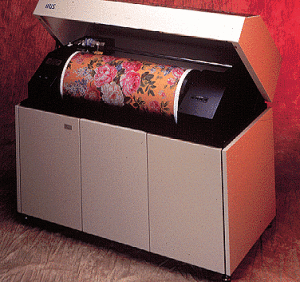What are Giclée prints and what do they have to do with Rock & Roll?
Giclée (pronounced zhee-CLAY) is a term often heard in the artist print market. But what exactly does it mean? First, let’s look at the history. In the early 1980’s, at the dawn of personal computers, there were few choices for printing. Dot matrix printers could only print letters. (Remember the crude attempts of printing graphics made up entirely of x’s?) The first inkjet printers were barely suitable for printing a pie chart, and the first black and white laser printers were great for type but not useful for art. You could make beautiful artwork onscreen, but printing it was impossible.
Then, in 1985 came the Iris printer. Costing well over $100,000, it was created specifically for the prepress market, so that printing companies could show their customers accurate color proofs before it went on press. In the late 1980’s a few early computer artists realized the potential of this technology and started using these
printers for their artwork. This is where rock & roll comes in. Graham Nash, from the band Crosby, Stills, Nash & Young, was the first to purchase an Iris printer for fine art printing in 1989. His company, Nash Editions, is still in business today (using Epson printers). In 1991, one of his employees, Jack Duganne, came up with the term giclée because they wanted to distance themselves from the business/industrial aspects of this technology. It is a made up word, based on the French word for nozzle: gicleur. (Unfortunately, giclée is also French slang for male ejaculation, so you might not want use this term in France!)
So when you order a giclée print from a printer now, what does it mean? Since it’s a made-up obsolete marketing term, it’s hard to say. If you go to the websites for the major inkjet printer companies (HP, Epson, Canon, and Kodak) and search “giclée”, there are no results. There are no giclée printers, papers or inks. What you should expect from a giclée print (or any print suitable for artwork) is a print made using archival inks, archival papers and color quality control.
Archival Inks
20 years ago when I worked at a commercial printer, I saw dye sublimation prints from our expensive proofing printer fade away in a few years while stored in a drawer! Today, professional inkjet printers use pigmented inks that are very lightfast. How lightfast is hard to say. There are no standards for testing inkjet papers and inks from company to company, so all we have are claims by the printer manufacturers. What really matters is how the work is displayed. Any piece of artwork or print will fade if displayed in bright light, and whether or not it’s matted and framed in an archival mat with an archival backing, using UV filtering glass, etc.. The fact is, your prints will eventually fade, but if they are printed on an inkjet printer using pigmented inks, it will last long enough if properly handled.
Archival Paper
Look for brand name papers such as Kodak, Epson, Fuli, Moab, and Somerset. Check to see if they are using the professional versions of these papers vs the consumer line (Kodak Endura and Fuji Crystal Archive are professional papers). Generally, the less coating on the paper and the fewer brighteners they use to make the paper white, the more archival. Most of the better inkjet papers are 100% acid free. According to Epson, their Epson Watercolor and Fine Art papers can last up to 200 years when printed on certain Epson printers using their longer lasting archival inks. But, even their coated papers, printed on some of their inexpensive consumer model printers will last 70-80 years!
Color Quality Control
Look for a printing company that provides color profiles for all their various papers. Your prints will look different on the various different brands and paper surfaces, and these profiles will help you preview the differences onscreen in Photoshop. This only works if your monitor is calibrated, but just the fact that the company provides them means that they are serious about color and are calibrating their equipment.
Conclusion
If you are shopping for a place to make your prints, ignore the term giclée. Look for a printing company that provides color profiles, gives good instructions on what type of file to provide (such as resolution in PPI) and what colorspace they prefer (such as sRGB or CMYK) and follow their instructions. A printer that caters to professional photographers is a great choice since they are looking for the same things artists are looking for: quality, accurate color, longevity, and quick turnaround. Look for high quality professional papers. Choose matt papers if you are concerned about it lasting longer than you or your grandchildren. Otherwise, choose what you think will look best. The glossier the paper, the more detail you will see. Matt papers will look more like an art paper. Epson makes a watercolor paper that renders prints of watercolors so well you can’t tell the difference. Be wary of drugstore prints made while you wait – they use dye sublimation technology which is not as long lasting as an inkjet.
DIY
Epson has long led the field in archival inks and papers. They have several inexpensive printers that they claim will provide prints that will last well beyond your lifetime if properly handled. Whatever printer you use, try to use their brand of paper and inks. Each brand designs their printers to work best and last longer with their own brand of ink and paper. But beware of the cost of materials. You’ll find it’s way more economical to order prints than to print them yourself.
And stop using the term giclée! It’s an inkjet. No matter where you get your inkjets printed, at home, your local copy shop, an online professional photo printer, or a high-end printer that caters to artists. They are all using inkjet technology. Many of them are using the exact same printers, inks and paper. You might get great inexpensive prints at your local copy shop. Make some prints, put them in a window and see if they fade. Experiment with different papers. Look for specials online. Have fun with your prints!
https://en.wikipedia.org/wiki/Iris_printer
http://www.nasheditions.com/the-work
http://kenallennews.com/2012/02/16/to-giclee-or-not-to-giclee/
https://en.wikipedia.org/wiki/Gicl%C3%A9e#cite_note-6
http://www.bhphotovideo.com/explora/photography/buying-guide/inkjet-paper
http://www.epson.com/cmc_upload/pdf/c31448_PermFlyerHoriz.pdf
http://www.wilhelm-research.com/WIR_RealClearTechnology/RealClearTechnology.html


















